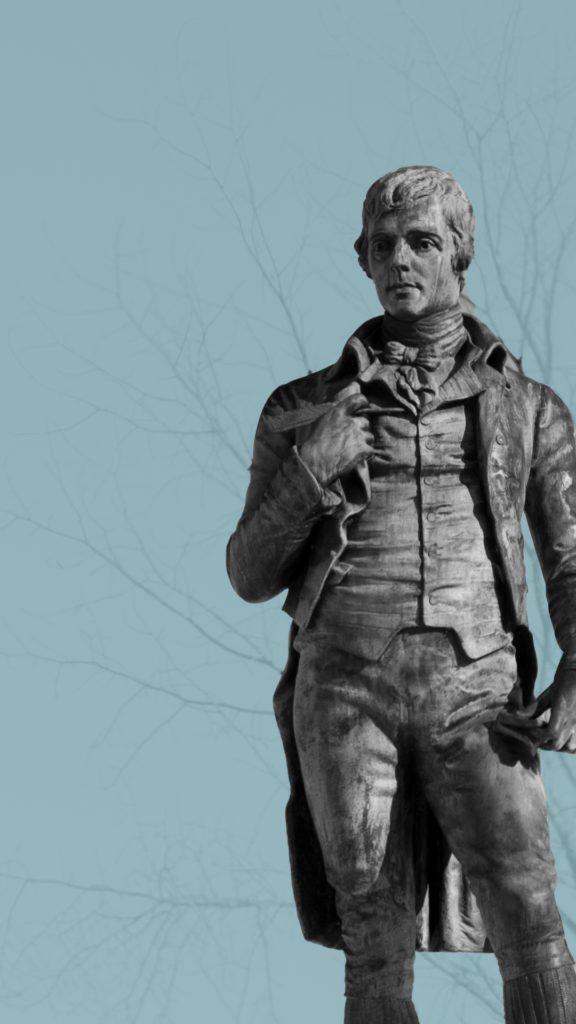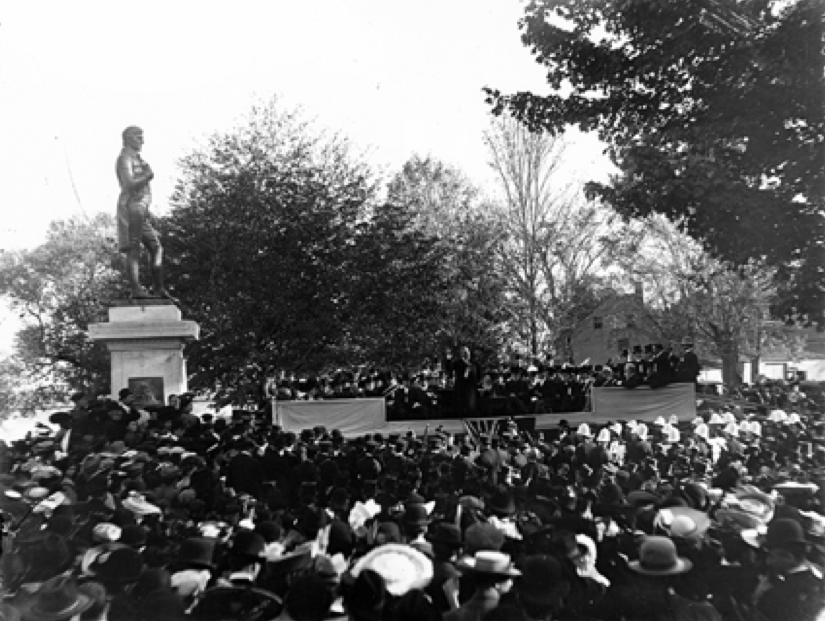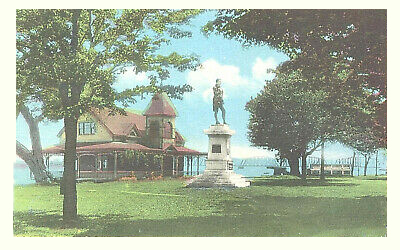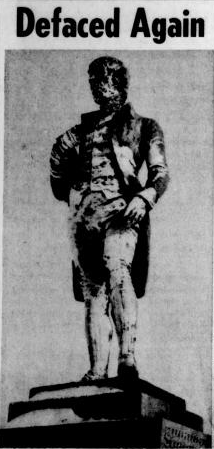A look back at the early (and colourful) history of Fredericton’s Robert Burns statue.
Matt Carter
 For over a hundred years the patron saint of Scottish poets, Robert Burns, has cast his bronze gaze upon the New Brunswick Legislative Building from his perch along the south side of the Saint John River. Erected in honour of the many Scots who immigrated to the province during the eighteenth and nineteenth centuries, the bard’s presence in our downtown remains a nod to our collective past and a touch of added scenery during morning commutes and evening strolls along the riverfront. While questions surrounding the poet’s sexual exploits have led to public arguments in the UK as to whether or not Burns was a womanizer or as one contemporary Scottish poet has charged, a “Weinsteinian sex pest”, his statue’s presence in New Brunswick’s capital has managed to avoid such scrutiny. But that’s not to say his 116 years have been uneventful.
For over a hundred years the patron saint of Scottish poets, Robert Burns, has cast his bronze gaze upon the New Brunswick Legislative Building from his perch along the south side of the Saint John River. Erected in honour of the many Scots who immigrated to the province during the eighteenth and nineteenth centuries, the bard’s presence in our downtown remains a nod to our collective past and a touch of added scenery during morning commutes and evening strolls along the riverfront. While questions surrounding the poet’s sexual exploits have led to public arguments in the UK as to whether or not Burns was a womanizer or as one contemporary Scottish poet has charged, a “Weinsteinian sex pest”, his statue’s presence in New Brunswick’s capital has managed to avoid such scrutiny. But that’s not to say his 116 years have been uneventful.
Our Burns was not only Fredericton’s first statue but one of the very first statues erected anywhere in the province and is one of only a handful of statues that stand in the city today. We’ve been lucky. We have no bronze cast military generals or overly controversial political figures standing watch over our downtown district. Nothing of the kind in fact. The only statues that come to mind are the Boss Gibson statue in Marysville Place, Burns’ new neighbour Lord Beaverbrook – recently relocated from his long-held perch in Officer’s Square – and that of a seven foot naked man (Riace IV, by Dame Elisabeth Frink) who keeps to himself amidst other public works on display in the Beaverbrook Art Gallery’s TD Sculpture Garden. On the statue front, we’re doing OK.
Up until the early twentieth century, Burns’ presence in Fredericton was limited to poems held in memories and in printed collections. At the time, New Brunswick was home to a number of thriving Scottish cultural societies with chapters scattered across the province. These groups organized picnics, dinners, concerts and other get-togethers as part of a greater effort to help preserve many of the cultural traditions familiar to their membership. Members then, and now, will be familiar with the poet’s Address to a Haggis, commonly recited at the two most celebrated events on the immigrant Scot’s calendar: Burns Night (January 25) and Saint Andrew’s Day (Nov. 30).
By 1900, Scottish immigrants across much of North America were beginning to mark their presence with plaques and monuments honouring Burns and his legacy as a symbol of national pride. Scottish communities in New York City, Victoria and Toronto claim three of North America’s earliest Burns monuments with likenesses erected in 1880, 1900 and 1902.
News of this growing trend eventually reached Fredericton and in 1903, members of the Fredericton Society of Saint Andrew had begun looking into erecting a similar monument to honour the province’s own Scottish heritage. In early February 1904 members of the Fredericton and Saint John Saint Andrew’s Societies met to discuss the idea. The interest and support was unanimous. A joint committee was then formed to lead the planning and fundraising.
Such an ambitious project would have surely raised a number of challenges. There was a lot to sort out, but it didn’t take the group long to finalize the groundwork and get the initial ball rolling. How exactly they would raise the necessary funds remained unknown at the outset, but what they did know was enough to move the project ahead. The statue would be Burns, the statue would be bronze and the sculpture would be Scottish.

The project involved Midlothian sculpture William Grant Stevenson with James Buchanan & Co. of Edinburgh handling the casting and Macintosh-Gullett Granite Company of Toronto providing the statue’s base. All this came with a price tag of $6500, or in today’s dollars, roughly $205,000. As ambitious a goal as it was, the provincial committee eventually raised most of the funds needed and two years later on October 18, 1906, the Burns statue was officially unveiled before a crowd that some estimates place at close to 5000 people. The master of ceremonies for the event was Duncan Cameron Fraser, ninth Lieutenant Governor of Nova Scotia. Following the ceremony, a local piper marched the many visitors back to the train station on York Street to catch their coaches home. The event made headlines across North America including a mention in the Scottish American Journal out of New York. A writer from the local paper called the monument, “the finest of its kind this side of the great Atlantic.”
At the time of the unveiling, all but $700 (or about $22,000 in today’s money) of the $6500 price tag had been collected. At the next regular meeting of the Fredericton Society of Saint Andrew held just weeks later, it was decided that a concert would be held at the Opera House (now City Hall) with all funds raised going to cover the remaining balance. The Society was also on the hook for an additional $150 to replace a bandstand that was removed to make way for the statue. With all the green space that exists along the waterfront to this day, it’s hard to understand why the statue couldn’t have been placed a few meters to the east or west of this preexisting structure. Perhaps another location would have obstructed the poet’s view of government. This tiny detail, it seems, has been lost to history.
The concert was held on January 23, 1908, a year and change after the statue was unveiled. The evening’s entertainment included highland dancers, cornet, violin and bass soloists, a vocal solo by Major A. E. Massie who came all the way from Montreal to perform, various readings and a male chorus. Piper W. H. Ross of Saint John also performed duets with guest vocalists. A feature in the local paper which ran the previous day describing the upcoming concert also mentioned that, for anyone who was wondering, “the results of the Victoria-Capital hockey game happening in Moncton that night would be announced every ten minutes from the stage.” Though the concert was deemed a big success and a glowing review ran on the front page of the local paper the following Monday, the event didn’t manage to generate enough money to cover the debt and Burns would continue to be the centre of fundraising efforts for years to come.
Besides the financial burden that lingered long after the statue was erected, a new issue soon began to develop, one that threatened to compound the existing debt owed on the bard’s likeness. By August 1909, the statue, which was supposed to be bronze, was beginning to show signs of iron rust which was also damaging the monument’s granite base. Two months later, representatives from the Macintosh Granite Company of Toronto visited Fredericton to inspect the statue and meet with the statue committee, now tasked with organizing repair work on their three year old monument. News of the defect eventually reached Scotland and by December 1909 the sculptor, William Grant Stevenson, was said to have secured the services of two lawyers, presumably to protect his credibility, and firmly placed the blame on the Edinburgh foundry responsible for casting the statue. Both Stevenson and James Buchanan & Co. had worked together to create earlier monuments including at least two others said to be from the same set of molds used to create our Burns. The first was erected in Denver, Colorado in July 1904 and another in Chicago, Illinois erected in August 1906, just two months prior to Fredericton’s statue unveiling. While no records exist detailing the conversations between Fredericton’s St. Andrews Society, the sculptor, the foundry, or the Toronto company that cut the statue’s base, the issue was eventually resolved and a new casting of the Burns statue arrived by rail on September 11, 1911 and was erected without ceremony days later.
By the fall of 1911, more than seven years after the idea of erecting a Burns monument was first floated at a meeting of Frederictron’s St. Andrews Society, it would seem that the story had run its course. After years of ongoing public updates in the local newspaper that closely followed the planning, the fundraising, the unveiling, the continued fundraising and eventually replacement, the story of Fredericton’s Burns statue seemed complete. While quarterly updates on other activities related to the Society continued to appear in the form of tiny news stories hidden amidst regular reports from the Lions Club and the Knights of Columbus, it would be another nine years before Burns would once again make the headlines.

On November 4, 1920, a $100 dollar reward was offered for information that would lead to the arrest of the person or persons responsible for defacing the Burns statue with a can of paint. And for the next fifty years, the only time Burns would make the news in Fredericton was after receiving one of dozens of unwanted touch-ups. On occasion, his shoes would get painted green, his vest red, and on a few rare occasions, the entire statue would get a new coating of paint.
Some have attributed these regular acts of vandalism to one of many traditions at the time associated with student groups at the University of New Brunswick. In 1949, it was speculated that one of Burns’ many unwanted makeovers was linked to a break and enter at one of UNB’s workshops. The same evening thieves broke into the shop, Burns was given a fresh coat of silver paint. Years later, in May of 1957, three of the school’s students were caught after an adventurous evening painting train cars on York Street. It appears as though the three budding artists visited the bard prior to the rail yard where they were caught in the act and fined just days before graduating.
Lord Beaverbrook himself, whose likeness now resides next to Burns’ adjacent the Beaverbrook Art Gallery, made reference to these regular acts of vandalism upon receiving the Freedom of the City from Mayor H. S. Wright in 1958. In speculating exactly what his new freedom entitled, Beaverbrook wondered aloud, “Does it mean I can show this beautiful inscription to police and that they will take notice of it? That is what I hope. Can I paint Bobby Burns red with policemen standing about me holding the paint pots?”.
Of the many stories that ran in the local paper between 1920 and the early 1960’s detailing Burns and his many vandals, none seemed to highlight these acts more than the feature included in the March 16, 1961 edition of The Daily Gleaner where a front page story included the headline, Burns Smeared with Green Paint: Shocked Public Demands Apprehension. I’ve chosen to include the full article here as I believe it speaks to the frequency in which these acts occurred. And on a less serious note, some of the quotes included sound as if they were pulled from a Hollywood writer’s room.
 A shocked citizenry today demanded the immediate capture and punishment of the hoodlums who overnight did a hideous head to toe paint job on the Bobbie Burns statue on The Green. The statue’s face itself was turned into a great glob of green paint, apparently in what was intended to be a poor joke for tomorrow, March 17, St. Patrick’s Day.
A shocked citizenry today demanded the immediate capture and punishment of the hoodlums who overnight did a hideous head to toe paint job on the Bobbie Burns statue on The Green. The statue’s face itself was turned into a great glob of green paint, apparently in what was intended to be a poor joke for tomorrow, March 17, St. Patrick’s Day.
When called by The Daily Gleaner this morning, Police Chief Bryce Neely said his department had not heard of the vandalism but would make an immediate investigation. “This is an outrage,” he said.
If caught, the culprits would be charged with damage to property, he said. Two UNB students caught about ten years ago while painting the statue were fined in court and made to clean off the paint under supervision of a police officer.
Claude Russell, assistant curator of the Beaverbrook Art Gallery, near the statue said of the vandalism: “Tactics such as these are not an encouragement to the arts in Fredericton. Who would want their sculptures subject to such treatment?
“This statue has been damaged in the past by similar acts,” said Mr. Russell. “The paint and its removal permanently damaging the patina of the bronze.”
Frank H. Creighton, chairman of the Tourist and Convention Committee of the Fredericton Board of Trade said Fredericton’s reputation as a tourist and convention centre has been damaged by the treatment given the statue, often described as the finest likeness of Burns in existence.
“This is a terrible thing to occur,” said Creighton. “The city should act quickly to try and clean it up, to find those responsible, and endeavor once and for all to prevent further outrages of this nature. It’s time for vandalism like this to be halted. The statue, remember, is right next door to the Beaverbrook Art Gallery.”
F. Callbeck, secretary manager of the Board of Trade recalled that a can of black paint smeared on the Burns statue last summer had not been removed – it still desecrated the monument’s base at the time of the latest vandalism and “probably encouraged the vanadals to believe they could get away with this new assault. It’s too bad this had to happen right when Fredericton is known as Canada’s City of the Year.”
It was urged today that any citizens who happened to be in the vicinity of the statue when the paint smearing was being done should immediately notify the police and give any help which might bring about the early arrest and conviction of those responsible.
“I abhor this sort of thing,” Mayor William T. Walker. “A full scale investigation will be made to track down and punish those responsible. Personally, I believe there is no room in Fredericton for anyone who does this sort of thing. The Burns statue on The Green is one of the things that makes Fredericton a beautiful, historic and cultural city. It is part of our way of life. The damage is a blow struck against all of us,” the Mayor said.
The colourful history of our Burns Statue continues to unfold. By 2009 the unwanted paint jobs appeared to have come to an end but new issues were developing. 103 years after it was erected, the statue was removed for repair, its base damaged by repeated flooding of the Wolastoq River. This raised the question of who is responsible to pay for repairs. The city? The Scottish community? A generous donor eventually came forward, but not after tempers flared with the Letters to the Editor sections of New Brunswick newspapers acting as a battleground. But that’s a story for another time.




